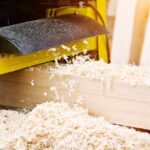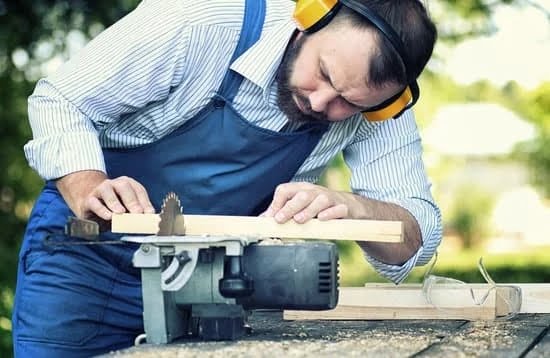Woodworking is a timeless craft that requires precision, skill, and the right tools. Among those tools, a table saw plays a pivotal role in achieving accurate and efficient cuts. Whether you’re a professional woodworker or a DIY enthusiast, knowing what to look for in a good table saw is essential. In this article, we will explore the key features and considerations when choosing the perfect table saw for your woodworking needs.
A quality table saw serves as the heart of any woodworking shop. It allows you to make straight cuts, crosscuts, bevels, and even intricate joinery with ease and precision. From cutting large sheets of plywood to delicate pieces of hardwood, a good table saw gives you control over your projects like no other tool can.
However, not all table saws are created equal. To find the best one for your specific woodworking needs, it’s important to understand the key features to consider. With so many options available on the market – from contractor and cabinet saws to hybrid models – selecting the right one can seem overwhelming. That’s why in this article, we will delve into the must-have features that define a good table saw.
So whether you’re just starting out in woodworking or looking to upgrade your current equipment, understanding what makes a good table saw is crucial. From precision and accuracy to durability and safety features – we will cover everything you need to know to ensure that your woodworking journey starts off on the right foot. Let’s dive in.
Key Features to Consider
When it comes to choosing a good table saw for woodworking, there are several key features that you should consider. Understanding these must-have features will help you make an informed decision and ensure that you are getting a table saw that meets your needs.
Types of Table Saws
One important factor to consider is the type of table saw that you need. There are several different types available, including contractor, cabinet, hybrid, and portable table saws. Each type has its own set of advantages and disadvantages, so it’s important to choose one that aligns with your specific woodworking requirements.
Motor Power and Blade Size
The motor power and blade size of a table saw are crucial factors in determining its cutting capabilities. A more powerful motor will allow for smoother cuts through dense materials, while a larger blade size provides increased cutting depth and capacity. It’s important to consider the types of projects you’ll be working on and choose a table saw with adequate motor power and blade size to handle them effectively.
Fence System
Another feature to consider is the fence system of the table saw. The fence is responsible for guiding the workpiece during cutting and ensuring accurate and straight cuts. Look for a table saw with a sturdy, easy-to-adjust fence system that locks securely into place to provide stability and precision.
Safety Features
Safety should always be a top priority when working with any power tool, especially a table saw. Look for safety features such as a reliable blade guard to protect against accidental contact with the spinning blade, anti-kickback pawls to prevent workpieces from being thrown back at you, and a riving knife to prevent material binding during rip cuts.
Remember that these are just some key features to consider when looking for a good table saw for woodworking. It’s important to thoroughly research your options and prioritize the features that are most important for your specific projects and needs. By doing so, you can ensure that you make the right choice and invest in a table saw that will help you achieve accurate and efficient cuts in your woodworking journey.
Precision and Accuracy
When it comes to woodworking projects, precision and accuracy are paramount. A good table saw plays a crucial role in achieving these qualities in your work. In this section, we will discuss the key factors that contribute to precision and accuracy in a table saw.
One important aspect to consider is the cutting capacity and squareness of the table saw. The cutting capacity refers to the maximum depth and width of material that can be cut by the saw. It is essential to choose a table saw with a cutting capacity that aligns with your woodworking needs.
Additionally, squareness refers to how perpendicular the blade is to the table surface, ensuring precise cuts every time. An adjustable miter gauge and rip fence also contribute significantly to accuracy by allowing you to make precise angle and parallel cuts.
Another factor that affects precision and accuracy is the bevel and miter adjustments of the table saw. These adjustments allow you to tilt the blade at different angles or adjust it for angled cuts, respectively. A good quality table saw should have consistent and easy-to-use bevel and miter adjustment mechanisms, ensuring accurate cuts at various angles.
In order for your table saw to provide precise and accurate cuts, it is crucial to regularly maintain it by checking for any misalignments or wear on components like the rip fence, miter gauge, or blade itself. Regular cleaning of dust particles from these components also helps maintain accuracy in your cuts.
Durability and Stability
Durability and stability are crucial factors to consider when choosing a table saw for woodworking. A sturdy construction ensures that the table saw can withstand heavy use and last for many years, while stability ensures smooth and accurate cuts. In this section, we will delve deeper into the importance of durability and stability in a table saw, discussing key considerations such as construction materials, tabletop quality, and stand or base design.
Robust Construction: Built to Last
One of the first things to look for in a durable table saw is a robust construction. Quality materials, such as cast iron or steel, provide strength and rigidity to the overall structure of the saw. These materials also help dampen vibrations during operation, resulting in smoother cuts.
Additionally, pay attention to the build quality of the parts and components. Check if they are well-made and properly aligned. Loose or poorly assembled parts can not only compromise the accuracy of your cuts but also indicate an inferior-quality table saw that may not last long.
Vibration-Free Tabletop: A Stable Surface
A stable tabletop is essential for achieving precise cuts. Look for a table saw with a flat and vibration-free surface. Cast iron tops are known for their excellent stability due to their weight and resistance to vibrations. They offer solid support for your workpiece as well as reduce resonance during cutting, ensuring cleaner results.
Another aspect to consider is the table extension wings. Ensure that they are firm and level with the main tabletop since any deviation can affect your cuts’ accuracy. Some high-end models also feature coated surfaces or T-slots on the tabletop, allowing you to easily slide materials across or attach accessories like featherboards or jigs.
Sturdy Stand or Base: Keeping Your Saw Secure
Having a stable stand or base is just as important as having a robust tabletop. Look for a table saw that comes with a sturdy stand or base designed to withstand the weight and vibrations of the machine. A well-built stand will provide a solid foundation, minimizing any wobbling or rocking during operation.
Consider the design of the stand or base as well. Some models come with integrated wheels, making it easier to move the table saw around your workshop. Others may have adjustable feet for leveling on uneven surfaces. These features not only enhance stability but also improve overall ergonomics and usability.
By prioritizing durability and stability in your choice of table saw, you can ensure a long lifespan for your investment and enjoy steady performance that consistently delivers precise cuts.
Safety First
A table saw is a powerful tool that can be very dangerous if not used properly. Therefore, when looking for a good table saw for woodworking, one of the most important factors to consider is the presence of essential safety features. These features are designed to protect the user from potential accidents and ensure a safe working environment. Here are some key safety features that you should look for in a good table saw:
- Blade Guard: A reliable blade guard is an essential safety feature that helps to prevent accidental contact with the spinning blade. It should be sturdy, easy to install and remove, and allow for clear visibility of the cutting area.
- Riving Knife: A riving knife is a thin metal plate positioned just behind the blade that prevents wood from pinching against the back of the blade and causing kickback. This safety feature is crucial in reducing the risk of serious injuries.
- Anti-kickback Pawls: Anti-kickback pawls are small devices attached to the table saw’s rip fence or splitter that are designed to grab onto wood and prevent it from being kicked back towards the user. They provide an extra layer of protection against kickbacks.
- Push Sticks: Push sticks are simple yet effective tools that allow users to guide materials through the blade without putting their hands at risk. They help maintain control over smaller pieces of wood, preventing fingers from getting too close to the blade.
- Emergency Stop Switch: An emergency stop switch is a large, easily accessible button located on or near the table saw’s control panel. It instantly shuts off power to the machine in case of an emergency or potential danger.
- Dust Collection System: While not directly related to personal safety, having an effective dust collection system helps maintain a clean work environment and reduces airborne particles that can be harmful when breathed in.
Ensuring that your chosen table saw includes these essential safety features will not only prioritize your well-being but also contribute to a more productive and enjoyable woodworking experience. Remember, safety should always be your top priority when working with power tools.
Ease of Use
When considering a table saw for your woodworking needs, it is crucial to factor in the ease of use and user-friendly design of the machine. Working with a table saw that is difficult to operate or lacks clear adjustments can not only slow down your progress but also compromise the quality and accuracy of your cuts. In this section, we will explore the key aspects of ease of use in a good table saw.
Easy-to-Read Scales and Clear Cutting Guides
One of the first things to look for in a user-friendly table saw is clear and easy-to-read scales. These scales are typically found on the rip fence, miter gauge, and bevel adjustment components. Having precise measurement markings makes it easier to set accurate cuts without confusion or guesswork. Additionally, clear cutting guides help ensure that your wood pieces are aligned correctly before making any cuts, further enhancing accuracy.
User-Friendly Blade Changing Mechanism
Another important feature to consider is a blade changing mechanism that is simple and straightforward. A good table saw should have an easily accessible arbor lock that allows you to change blades quickly and securely. The process should be hassle-free without requiring any additional tools or complicated steps. This convenience not only saves time but also reduces the risk of accidents that may occur when struggling with a cumbersome blade changing system.
Tool-less Fence Adjustments and Effortless Mobility
A user-friendly table saw should also provide convenient fence adjustments. Look for models that offer tool-less fence adjustments, allowing you to easily move or secure the fence in place without needing extra tools or excessive effort. This feature enables quick setup and precise positioning for various woodworking tasks.
Additionally, having effortless mobility can greatly enhance the usability of your table saw. Opt for models equipped with sturdy wheels or a portable design that allows you to move the machine around your workshop with ease. This mobility ensures flexibility in your workspace and makes it easier to accommodate different project requirements.
By prioritizing ease of use and user-friendly design in your search for a table saw, you can streamline your woodworking processes and achieve more consistent results with less effort. Remember to consider features like easy-to-read scales, clear cutting guides, a tool-less fence adjustment system, and effortless mobility when making your decision. These considerations will contribute to a smoother woodworking experience and help you get the most out of your table saw.
Additional Features and Accessories
A good table saw is a versatile tool that can be used for a wide range of woodworking projects. While the standard features of a table saw are essential, there are additional features and accessories that can enhance its versatility and make your woodworking experience more efficient and enjoyable.
One key feature that can enhance the functionality of your table saw is expandable table extensions. These extensions provide additional support for larger materials, allowing you to work with longer or wider pieces without the risk of them falling off the table or losing stability. They can greatly increase the cutting capacity of your table saw, making it easier to handle large-scale projects such as building furniture or constructing cabinets.
Another accessory that can improve the versatility of your table saw is a miter sled. A miter sled is a sliding platform that allows you to make precise crosscuts at various angles. It provides stability and accuracy when cutting small pieces or making intricate cuts, such as miters or bevels. With a miter sled, you can achieve clean and precise cuts consistently, ensuring professional-looking results.
In addition to expandable table extensions and miter sleds, there are other accessories that can further enhance the functionality of your table saw. A dado insert, for example, allows you to make dado cuts (wide grooves) in wood by replacing the regular blade insert on your table saw. This enables you to create strong joints for assembling furniture or shelving units.
Furthermore, dust collection accessories are essential for maintaining a clean and healthy working environment. Dust created from cutting wood can be hazardous if inhaled regularly over time. Installing a dust collection system on your table saw helps capture and remove airborne particles before they have a chance to circulate in your workshop.
By incorporating these additional features and accessories into your table saw setup, you can greatly expand its capabilities and adapt it to different woodworking tasks. Whether you’re a professional woodworker or a hobbyist, these enhancements can make your projects more enjoyable and efficient.
| Additional Features and Accessories | Enhancements |
|---|---|
| Expandable table extensions | Increased cutting capacity for larger materials |
| Miter sled | Precise crosscuts at various angles |
| Dado insert | Create dado cuts for strong joints |
| Dust collection accessories | Capture and remove airborne particles for a cleaner working environment |
Price Range and Recommendations
When it comes to purchasing a table saw for woodworking, considering your budget is an essential step in the decision-making process. Table saw prices can vary greatly depending on the brand, model, features, and overall quality. Therefore, it is important to determine a suitable budget that aligns with your woodworking needs.
For those on a tight budget or just starting out in woodworking, there are several affordable options available that still offer decent performance and functionality. These budget-friendly table saws may have smaller motors or fewer advanced features, but they can still get the job done effectively for simpler projects.
If you have a slightly larger budget and require more power and versatility for your woodworking projects, mid-range table saws are worth considering. These models typically offer more robust motors, larger cutting capacities, and enhanced safety features. While they may be pricier than entry-level options, mid-range table saws provide better performance and durability.
For professional woodworkers or enthusiasts who prioritize top-notch quality and advanced features, high-end table saws are the way to go. These premium models often boast powerful motors with high RPMs, superior dust collection systems, precision fences, and innovative safety mechanisms. While they come at a higher price point, high-end table saws deliver exceptional performance and longevity.
To make an informed decision about which table saw is right for you within your budget range, it is helpful to read online reviews and take advantage of resources such as buyer’s guides or forums where experienced woodworkers share their insights. These resources can provide valuable information about a particular model’s reliability, performance under heavy use, and other factors that may influence your purchasing decision.
Remember that while price is an important factor in choosing a table saw for woodworking, it should not be the sole determining factor. Assessing the key features discussed earlier in this article – such as motor power, cutting capacity, safety features, and ease of use – alongside your budget can help you find the perfect table saw that meets both your woodworking needs and financial constraints.
Conclusion
In conclusion, finding the right table saw for your woodworking journey is crucial for achieving accurate and efficient cuts. As highlighted throughout this article, there are several key factors to consider when selecting a good table saw. From understanding the different types of table saws to evaluating precision and accuracy, durability and stability, safety features, ease of use, and additional accessories – each aspect plays a vital role in ensuring a successful woodworking experience.
When making your decision, it is important to prioritize your woodworking needs and invest in a reliable table saw that meets those requirements. Safety should also be a top priority, so selecting a table saw with essential safety features such as a reliable blade guard, riving knife, anti-kickback pawls, and effective dust collection system is crucial.
Furthermore, maintaining accuracy throughout your woodworking projects heavily relies on the quality of the chosen table saw. Ensuring precise cutting capacity and squareness, along with user-friendly design and adjustments like easy-to-read scales and clear cutting guides can greatly contribute to achieving accuracy.
Finally, don’t forget about durability and stability. Look for a table saw with robust construction, solid tabletops that minimize vibrations, and stable stands or bases that provide a sturdy foundation for your work.
By considering all these factors and investing wisely in a good table saw that aligns with your budget and goals as well as emphasizes safety and accuracy, you can set yourself up for success in your woodworking journey. Remember to take advantage of resources such as online reviews to make an informed decision. With the right table saw by your side, you will be well-equipped to tackle any woodworking project with confidence.
Frequently Asked Questions
What is a good table saw to buy?
There are several factors to consider when looking for a good table saw to buy. One important aspect is the power of the motor, which should be sufficient to handle the type of projects you plan on doing. A saw with at least 3-5 horsepower is generally recommended for most woodworking needs. Another crucial feature to look for is the rip capacity, which determines how wide of a board can be cut.
A larger rip capacity allows for greater versatility in cutting various sizes of lumber. Additionally, consider the build quality and durability of the table saw, as well as safety features such as blade guards and anti-kickback devices. It is also beneficial to read reviews and seek recommendations from experienced woodworkers who have used different table saw models.
What kind of saw is best for woodworking?
When it comes to woodworking, there isn’t necessarily one specific kind of saw that is considered the best for all purposes. Different types of saws excel at different tasks, so it depends on the specific woodworking project you are undertaking. However, one versatile and commonly used saw in woodworking is the circular saw or a compound miter saw.
Circular saws are portable and can make straight cuts across various materials including wood, making them suitable for a range of woodworking jobs like cutting boards or plywood sheets. Meanwhile, compound miter saws offer increased flexibility by allowing accurate angled cuts as well as beveling capabilities, making them advantageous for tasks like making precise crosscuts or miters.
How many teeth is best for a table saw?
The number of teeth on a table saw blade can greatly impact its performance and the quality of your cuts. In general, blades with more teeth tend to produce smoother finishes while blades with fewer teeth are better suited for faster cutting but may result in rougher surfaces. For most woodworking applications where precision is desired, a blade with around 40-60 teeth is often recommended by professionals and experienced woodworkers.
Having an appropriate number of teeth strikes a balance between achieving clean cuts without excessive tear-out or chipping. However, keep in mind that the number of teeth alone should not be the sole factor in assessing a table saw blade’s suitability for a specific job. Other factors such as the type and condition of the wood being cut, the desired cutting speed, and the type of cut required also need to be taken into consideration.

Hi everyone! I’m a woodworker and blogger, and this is my woodworking blog. In my blog, I share tips and tricks for woodworkers of all skill levels, as well as project ideas that you can try yourself.





